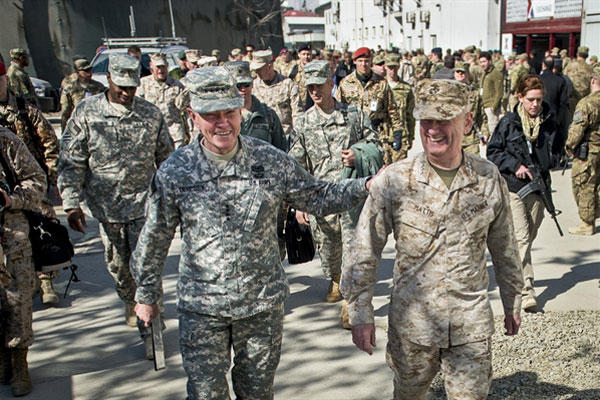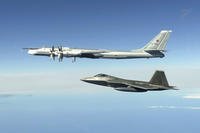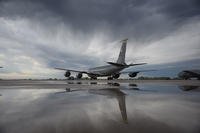In April, the U.S. Army plans to unveil a new camouflage strategy that could result in soldiers wearing Marine Corps desert and woodland patterns into combat.
Nearly one year ago, uniform officials completed an exhaustive, four-year camouflage improvement effort, but soldiers still wear the ineffective, three-color Universal Camouflage Pattern.
Staggering defense-spending cuts are partly to blame for the delay. Congressional pressure to do away with service specific camouflage patterns has also slowed the effort's momentum.
Out of the finalists -- Crye Precision LLC, ADS, Inc., teamed with Hyperstealth, Inc.; Brookwood Companies, Inc.; and Kryptek, Inc. -- there was no definitive winner. None of the four patterns clearly outperformed through all the test environments.
The Army has been considering replacing UCP with Crye Precision's MultiCam -- a pattern that has demonstrated consistent performance in test after test and was selected in 2010 for soldiers to wear in Afghanistan.
But Army officials don't want to pay Crye $24.8 million in royalties to use MultiCam, according to an Army source familiar with the effort.
Caleb Crye, the executive director of Crye Precision, did not respond to an interview request from Military.com.
As an alternative, uniform officials are planning to create a digital pattern made up of the color scheme used in MultiCam and testing it in various locations across the country during the month of March, the source said.
If all goes well, this digitized pattern would become the Army's primary camouflage pattern for garrison, training and real-world deployments, the source said.
The second part of the camouflage strategy involves adopting the Marine Corps desert and woodland patterns to be used as needed for specific operating environments around the world, the source said.
The move may be an attempt to calm congressional criticism of the services of wasting millions on service-specific camouflage patterns as lawmakers continue to wrestle with massive defense spending cuts under sequestration.
Congressional language in both the House and Senate Armed Services committee versions of the National Defense Authorization Act for Fiscal 2014 calls on the Pentagon to stop fielding service-specific camouflage patterns and instead develop a common pattern for the Army, Navy, Air Force and Marine Corps, by 2018.
Both versions talk about prohibiting the adoption of individual military service camouflage uniforms except under specific limited circumstances.
Military.com requested an interview with Program Executive Office Soldier to discuss the strategy. Instead, Army public affairs responded with the following statement.
"The Army continues to move forward with cammo testing. As in the past Phase IV Camouflage testing, the Army will continue to test existing service camouflage patterns, exploring all camouflage options that are in keeping with the law," Army spokesman William Layer said in an email. "This includes existing Navy and United States Marine Corps patterns-as it has all along."
All four services universally wore the Army Battle Dress and Desert Camouflage patterns before the Marine Corps introduced their digital patterns in 2002 and branded the Corps symbol into it. The Corps' initiative left Army, Air Force, and later Navy leaders scrambling to provide their troops service-specific camouflage patterns.
Army uniform officials launched the service's camouflage effort after Pennsylvania's Democratic Rep. John Murtha, got involved in the issue in 2009. Murtha was then chairman of the House Appropriations Subcommittee on Defense. He pushed the service to look for a better camouflage pattern after receiving complaints from sergeants about the UCP's poor performance in the war zone.
Murtha died in 2010, just before the Army selected MultiCam as the clear winner over several other patterns to issue to soldiers deploying to Afghanistan.
Some test community officials maintain that the 2004 adoption of the UCP was a mistake that could have been avoided, saving the Army billions of dollars on uniforms and matching equipment.
Two separate studies performed by Army scientists from Natick Soldier Systems Center, Mass. -- one completed in 2009 and the other in 2006 -- showed that the UCP performed poorly in multiple environments when compared to other modern camouflage patterns.
In both studies, MultiCam, a pattern popular with Special Operations Forces, outperformed UCP.
Critics of the UCP maintain that the service has spent $5 billion on uniforms and equipment all printed in the inadequate UCP. The Government Accountability Office estimates that the Army will have to spend another $4 billion on uniforms and equipment over the next five years if it selects its new family of camouflage patterns.
It's unclear how long it would take to implement the Army's latest camouflage strategy. Layer said that all the additional testing will be "scientifically rigorous" and could last through fiscal 2014.
-- Matthew Cox can be reached at Matthew.Cox@monster.com.






























